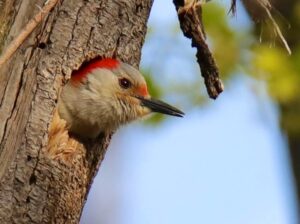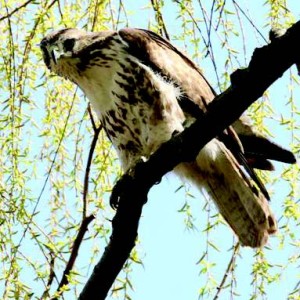
the western end of boardwalk near Amory Street.
Photo by Peter Lowy
Three consecutive Mondays
April 29, May 6, and May 13
7:00 to 8:30 AM
Whether it’s sunny, cloudy, or light rain!
Friends of Hall’s Pond will conduct guided bird walks timed for spring migration, on an easy half-mile loop, led by Neil Gore.
Where?
Meet at the gate behind 1120 Beacon St. (By the tennis courts)
by the tennis courts, an easy half-mile loop
Who?
Nature lovers wearing visored hats
(preferably) and binoculars (recommended)
Why?
Celebrating over 50 years of documenting bird migrations at Hall’s Pond
Contact: friendsofhallspond@gmail.com
Why Seek Birds at Hall’s Pond?
By Fred Bouchard
(From the Spring/Summer 2009 Friends of Hall’s Pond Newsletter)
“Why watch birds?” ask skeptical, even dismissive, acquaintances. “I’ll tell you why,” say l, reciting a list called “what birding can do for you.”
- Bring you close to nature. Birds are amazing: they’ve inspired and awed mankind in song and saga since dawn-age. Birds not only fly, but hover, wheel, soar, dive, and migrate incredible distances. Many have fascinating, complex songs and calls; resilient adaptive powers of survival; plumage that changes seasonally.
- Get you outdoors. Stretch your legs hiking the Pond’s paths and boardwalks (or even backroads, woods, mountains, beaches!) seeking elusive winged critters.
- Sharpen your eyes. Learning fine details of bird observation (field marks, habits, and movements) are critical to satisfactory (ie, accurate) bird identification.
- Retune your ears. Learn the songs, calls, and communicative noises made by the 100 species found at Hall’s Pond and 300 found in the Bay State each year. (Make that 800 nationally, and 10,000 worldwide.)
- Pique interest in botany, zoology, geography, natural history. Which berries do Cedar Waxwings eat? Which trees do Wood Ducks prefer for nest holes? Why do some Canada Geese migrate and others don’t?
- Improve map-reading, sense of direction. Finding a house on a signed street is one thing, but finding a 5” Nashville Warbler in a 10-acre park takes fine-tuning of your homing skills. Map- Quest gets you only so far.
- Teach ecology and habitat preservation. Everyone’s talking the talk of ‘green revolution’: hybrid cars, wind farms, compact fluorescents, canvas grocery bags, lights out, you name it. But who walks the walk? Birders, since before it was hot!
- Provide fun for a minute, a day, or a lifetime. You can bird actively during a ten-minute stroll or an allday hike. All you need to start is a good field-guide (Sibley’s or Peterson’s, $25) and decent binoculars).
- Travel with birds world-wide. Pop your binos in your backpack, read up on The Birds of Thailand or Costa Rica, and you can bird the globe.

Birds year round at Hall’s Pond include many regulars. Herring Gulls overhead. Starlings, Pigeons and Mourning Doves on the ball-field. Bright-red Cardinals wheet-wheeting in the trees, House Sparrows chirping in the bushes. The local Red-tailed Hawk being pestered by crows and jays.
Birds pondside in May double: Chimney Swifts, Swallows (Rough-winged and Tree) skim the pond; Grackles and Redwinged Blackbirds clack in the reeds; Great Blue Heron and Black-crowned Night Heron stalk and fish. Less obvious are singing warblers (Common Yellowthroat, Northern Waterthrush) and thrushes (Hermit, Wood). Perched on a branch may be a bull-headed, quickcackling Belted Kingfisher, E. Kingbird or Baltimore Oriole. Good birdin’!
